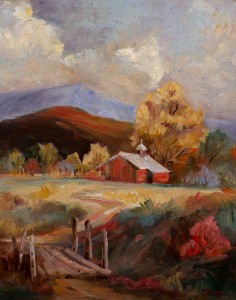
When a viewer looks at a painting, mostly what they see are color shapes on a two dimensional surface. Fortunately, color comes with three qualities: hues, value, and intensity. Most artists artist desire to represent their subject as a by product, and to do this, they must learn to put each color shape onto the canvas one after the other.
Learning to accurately utilize the three qualities of color is the secret to creating a three dimensional effect. Everyone understands a pure pigment (example: red, yellow, blue, and etc), however, an experienced artists knows the pure pigments are seldom used without considering the complexities that nature creates with light. It changes the value (how light or dark the color is). It changes the intensity (how bright or dull compared to the pure color).
Remember, using different colors side by side may change the overall effect of the colors themselves. One color painted next to its complement will draw one out while pushing the other back. All of this must be taken into account when painting. Understanding this and its intentional use helps to create more of a three dimensional effect in the painting.
The greatest affect on the hue, value, and intensity of color is light. Every painter paints light, because without it, there is nothing to see. However, light is constantly changing. A good experiment for any artist is to go out on different times of the day and paint “light” swatches of different objects. For example, an early morning light on a red barn is different than a midday light or an evening light. In some situations, the red barn is hardly red at all, however the viewer will see a red barn when looking at the painting. This is all an artist could ask for…correct? Experiment, play, and have fun creating.
Be sure to sign up for our ART CENTER INFORMATION NEWSLETTER (upper right hand side of the page). You also have a chance to win a beautiful art book~Splash 14.
Check out the opportunities page and the different galleries listed at top of the page.
